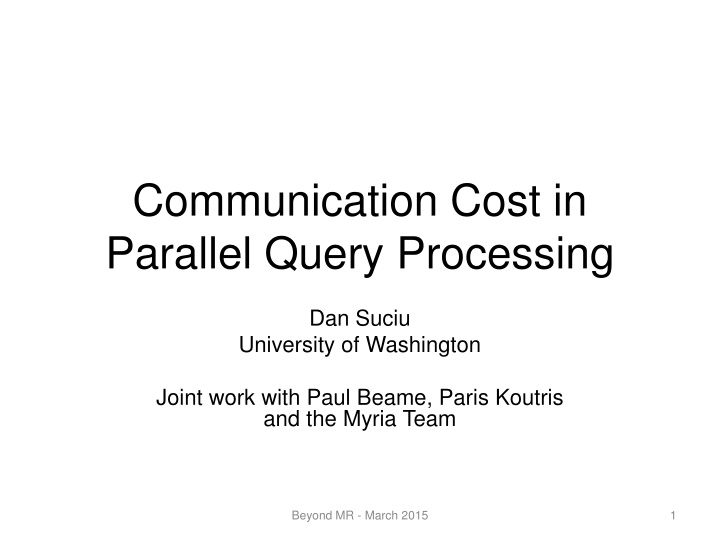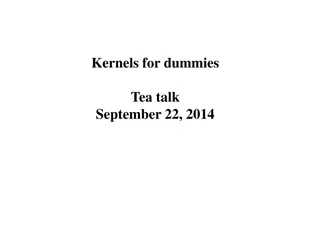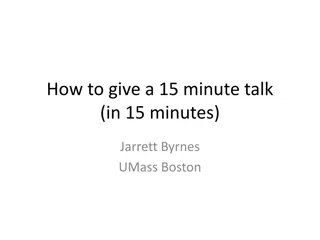
Communication Cost in Parallel Query Processing Study
Explore the communication cost in parallel query processing using the Massively Parallel Communication Model (MPC), extending BSP and Valiant's algorithms. The study delves into determining the necessary communication for computing queries on multiple servers, outlining different rounds and communication loads per round.
Download Presentation

Please find below an Image/Link to download the presentation.
The content on the website is provided AS IS for your information and personal use only. It may not be sold, licensed, or shared on other websites without obtaining consent from the author. If you encounter any issues during the download, it is possible that the publisher has removed the file from their server.
You are allowed to download the files provided on this website for personal or commercial use, subject to the condition that they are used lawfully. All files are the property of their respective owners.
The content on the website is provided AS IS for your information and personal use only. It may not be sold, licensed, or shared on other websites without obtaining consent from the author.
E N D
Presentation Transcript
Communication Cost in Parallel Query Processing Dan Suciu University of Washington Joint work with Paul Beame, Paris Koutris and the Myria Team Beyond MR - March 2015 1
This Talk How much communication is needed to compute a query Q on p servers?
Massively Parallel Communication Model (MPC) Extends BSP [Valiant] Input (size=m) Input data = size m O(m/p) O(m/p) Server 1 . . . . Server p Number of servers = p
Massively Parallel Communication Model (MPC) Extends BSP [Valiant] Input (size=m) Input data = size m O(m/p) O(m/p) Server 1 . . . . Server p Number of servers = p L L Round 1 Server 1 . . . . Server p One round = Compute & communicate
Massively Parallel Communication Model (MPC) Extends BSP [Valiant] Input (size=m) Input data = size m O(m/p) O(m/p) Server 1 . . . . Server p Number of servers = p L L Round 1 Server 1 . . . . Server p One round = Compute & communicate Round 2 L L Algorithm = Several rounds Server 1 . . . . Server p L L Round 3 . . . . . . . .
Massively Parallel Communication Model (MPC) Extends BSP [Valiant] Input (size=m) Input data = size m O(m/p) O(m/p) Server 1 . . . . Server p Number of servers = p L L Round 1 Server 1 . . . . Server p One round = Compute & communicate Round 2 L L Algorithm = Several rounds Server 1 . . . . Server p Max communication load / round / server = L L L Round 3 . . . . . . . .
Massively Parallel Communication Model (MPC) Extends BSP [Valiant] Input (size=m) Input data = size m O(m/p) O(m/p) Server 1 . . . . Server p Number of servers = p L L Round 1 Server 1 . . . . Server p One round = Compute & communicate Round 2 L L Algorithm = Several rounds Server 1 . . . . Server p Max communication load / round / server = L L L Round 3 . . . . . . . . Ideal L = m/p 1 Practical (0,1) L = m/p1- O(1) Na ve 1 L = m 1 Na ve 2 L = m/p p Cost: Load L Rounds r
Massively Parallel Communication Model (MPC) Extends BSP [Valiant] Input (size=m) Input data = size m O(m/p) O(m/p) Server 1 . . . . Server p Number of servers = p L L Round 1 Server 1 . . . . Server p One round = Compute & communicate Round 2 L L Algorithm = Several rounds Server 1 . . . . Server p Max communication load / round / server = L L L Round 3 . . . . . . . . Ideal L = m/p 1 Practical (0,1) L = m/p1- O(1) Na ve 1 L = m 1 Na ve 2 L = m/p p Cost: Load L Rounds r
Massively Parallel Communication Model (MPC) Extends BSP [Valiant] Input (size=m) Input data = size m O(m/p) O(m/p) Server 1 . . . . Server p Number of servers = p L L Round 1 Server 1 . . . . Server p One round = Compute & communicate Round 2 L L Algorithm = Several rounds Server 1 . . . . Server p Max communication load / round / server = L L L Round 3 . . . . . . . . Ideal L = m/p 1 Practical (0,1) L = m/p1- O(1) Na ve 1 L = m 1 Na ve 2 L = m/p p Cost: Load L Rounds r
Massively Parallel Communication Model (MPC) Extends BSP [Valiant] Input (size=m) Input data = size m O(m/p) O(m/p) Server 1 . . . . Server p Number of servers = p L L Round 1 Server 1 . . . . Server p One round = Compute & communicate Round 2 L L Algorithm = Several rounds Server 1 . . . . Server p Max communication load / round / server = L L L Round 3 . . . . . . . . Ideal L = m/p 1 Practical (0,1) L = m/p1- O(1) Na ve 1 L = m 1 Na ve 2 L = m/p p Cost: Load L Rounds r
Massively Parallel Communication Model (MPC) Extends BSP [Valiant] Input (size=m) Input data = size m O(m/p) O(m/p) Server 1 . . . . Server p Number of servers = p L L Round 1 Server 1 . . . . Server p One round = Compute & communicate Round 2 L L Algorithm = Several rounds Server 1 . . . . Server p Max communication load / round / server = L L L Round 3 . . . . . . . . Ideal L = m/p 1 Practical (0,1) L = m/p1- O(1) Na ve 1 L = m 1 Na ve 2 L = m/p p Cost: Load L Rounds r
Example: Join(x,y,z) = R(x,y), S(y,z) |R|=|S|=m S y z R x y b d a b O(m/p) O(m/p) b e a c Input: R, S Uniformly partitioned on p servers Server 1 . . . . Server p c e b c Round 1 Server 1 . . . . Server p R(x,y) S(y,z) R(x,y) S(y,z) Round 1: each server Sends record R(x,y) to server h(y) mod p Sends record S(y,z) to server h(y) mod p Assuming no skew Output: Each server computes the local join R(x,y) S(y,z) Load L = O(m/p) w.h.p. Rounds r = 1 12
Speedup Speed A load of L = m/p corresponds to linear speedup A load of L = m/p1- corresponds to sub-linear speedup # processors (=p) 13
Outline The MPC Model The Algorithm Skew matters Statistics matter Extensions and Open Problems 14
Overview Computes a full conjunctive query in one round of communication, by partial replication. The tradeoff was discussed [Ganguli 92] Shares Algorithm: [Afrati&Ullman 10] For MapReduce HyperCube Algorithm [Beame 13, 14] Same as in Shares But different optimization/analysis 15
The Triangle Query T Z X Input: three tables R(X, Y), S(Y, Z), T(Z, X) Fred Alice S Y Z Jack Jim Fred Alice Fred Jim R X Y |R| = |S| = |T| = m tuples Jack Jim Carol Alice Fred Alice Fred Jim Jack Jim Carol Alice Output: compute all triangles Trianges(x,y,z) = R(x,y), S(y,z), T(z,x) Fred Jim Carol Alice 16
|R| = |S| = |T| = m tuples Trianges(x,y,z) = R(x,y), S(y,z), T(z,x) Triangles in One Round Place servers in a cube p = p1/3 p1/3 p1/3 Each server identified by (i,j,k) Server (i,j,k) (i,j,k) k j i p1/3 17
|R| = |S| = |T| = m tuples Trianges(x,y,z) = R(x,y), S(y,z), T(z,x) Triangles in One Round T Round 1: Z X Send R(x,y) to all servers (h1(x),h2(y),*) Send S(y,z) to all servers (*, h2(y), h3(z)) Send T(z,x) to all servers (h1(x), *, h3(z)) Output: compute locally R(x,y) S(y,z) T(z,x) Fred Alice S Y Z Jack Jack Jim Jim Fred Alice Fred Jim R X Y Jack Jim Carol Alice Fred Alice Fred Jim Jack Jim Carol Alice Fred Fred Jim Jim Jim Jim Jack Jack Jim Jack Carol Alice Fred Jim (i,j,k) Fred Jim Jim Jack Fred Jim Fred Jim Fred Jim Fred Jack Jack Jim Jim Jack Jim Jim k j = h1(Jim) Jim Jack p1/3 18 i = h2(Fred)
|R| = |S| = |T| = m tuples Trianges(x,y,z) = R(x,y), S(y,z), T(z,x) Communication load per server TheoremIf the data has no skew , then the HyperCube computes Triangles in one round with communication load/server O(m/p2/3) w.h.p. Sub-linear speedup Can we compute Triangles with L = m/p? No! Theorem Any 1-round algo. has L = (m/p2/3 ) 19
|R| = |S| = |T| = 1.1M Trianges(x,y,z) = R(x,y), S(y,z), T(z,x) 1.1M triples of Twitter data 220k triangles; p=64 local 1 or 2-step hash-join; local 1-step Leapfrog Trie-join (a.k.a. Generic-Join) 2 rounds hash-join 1 round broadcast 1 round hypercube 20
|R| = |S| = |T| = 1.1M Trianges(x,y,z) = R(x,y), S(y,z), T(z,x) 1.1M triples of Twitter data 220k triangles; p=64
HperCube Algorithm for Full CQ pi= the share of the variable xi Write: p = p1 * p2* * pk Round 1: send Sj(xj1, xj2, ) to all servers whose coordinates agree with hj1(xj1), hj2(xj2), h1, , hk = independent random functions Output: compute Q locally
Computing Shares p1, p2, , pk Suppose all relations have the same size m Load/server from Sj : Lj = m / (pj1 * pj2 * ) Optimization problem: find p1 * p2* * pk = p Minimize j Lj [Afrati 10] nonlinear opt: Minimize maxj Lj [Beame 13] linear opt: 23
Fractional Vertex Cover Hyper-graph: nodes x1, x2 , hyper-edges S1, S2, Vertex cover: a set of nodes that includes at least one node from each hyper-edge Sj Fractional vertex cover: v1, v2, vk 0 s.t.: Fractional vertex cover value * = minv1, vk i vi 24
Computing Shares p1, p2, , pk Suppose all relations have the same size m v1*, v2*, , vk* = optimal fractional vertex cover Theorem. Optimal shares are: pi = p vi* / * Optimal load per server is: L = m / p1/ * Can we do better? No: 1/p1/ * = speedup Theorem L = m / p1/ * is also a lower bound.
L = m / p1/* Examples Integral vertex cover t* = 2 Triangles(x,y,z) = R(x,y), S(y,z), T(z,x) * = 3/2 Fractional vertex cover * = 5/2 5-cycle: R(x,y), S(y,z), T(z,u), K(u,v), L(v,x) 26
Lessons So Far MPC model: cost = communication load + rounds HyperCube: rounds=1, L = m/p1/ * Sub-linear speedup Note: it only shuffles data! Still need to compute Q locally. Strong optimality guarantee: any algorithm with better load m/ps reports only 1/ps *-1 fraction of answers. Parallelism gets harder as p increases! Total communication = p L = m p1-1/ * MapReduce model is wrong! It encourages many reducers p 27
Outline The MPC Model The Algorithm Skew matters Statistics matter Extensions and Open Problems 28
Skew Matters If the database is skewed, the query becomes provably harder. We want to optimize for the common case (skew-free) and treat skew separately This is different from sequential query processing, were worst-case optimal algorithms (LFTJ, generic-join) are for arbitrary instances, skewed or not. 29
Skew Matters 0 1 0 Join(x,y,z) = R(x,y),S(y,z) * = 1 L = m/p Suppose R, S are skewed, e.g. single value y The query becomes a cartesian product! Product(x,z) = R(x),S(z) 1 1 * = 2 L = m/p1/2 Lets examine skew 30
All You Need to Know About Skew Hash-partition a bag of m data values to p bins Fact 1 Expected size of any one fixed bin is m/p Fact 2 Say that database is skewed if some value has degree > m/p. Then some bin has load > m/p Fact 3 Conversely, if the database is skew-free then max size of all bins = O(m/p) w.h.p. Hiding log p factors Join: Triangles: if degree < m/p then L = O(m/p) w.h.p if degree < m/p1/3 then L = O(m/p2/3 ) w.h.p 31
Atserias, Grohe, Marx13 The AGM Inequality Suppose all relations have the same size m Theorem. [AGM] Let u1, u2, , ul be an optimal fractional edge cover, and * = u1+u2+ +ul Then: |Q| m * 32
The AGM Inequality Suppose all relations have the same size m Fact. Any MPC algorithm using r rounds and load/server L satisfies r L m / p1/ * Proof. Tightness of AGM: there exists db s.t. |Q| = m * AGM: one server reports only (r L) * answers All p servers report only p (r L) * answers WAIT: we computed Join with L = m / p now we say L m / p1/2 ? 33
Lessons so Far Skew affects communication dramatically w/o skew: L = m / p1/ * fractional vertex cover w/ skew: L m / p1/ * fractional edge cover E.g. Join from linear m/p to m/p1/2 Focus on skew-free databases. Handle skewed values as a residual query. 34
Outline The MPC Model The Algorithm Skew matters Statistics matter Extensions and Open Problems 35
Statistics So far: all relations have same size m In reality, we know their sizes = m1, m2, Q1: What is the optimal choice of shares? Q2: What is the optimal load L? Will answer Q2, giving closed formula for L. Will answer Q1 indirectly, by showing that HyperCube takes advantage of statistics. 36
Statistics for Cartesian Product 2-way product Q(x,y) = S1(x) S2(y) |S1|=m1, |S2| = m2 Shares p = p1 p2 L = max(m1 / p1 , m2 / p2) Minimized when m1 / p1 = m2 / p2 S1(x) S2(y) t-way product: Q(x1, ,xu) = S1(x1) St(xt):
Fractional Edge Packing Hyper-graph: nodes x1, x2 , hyper-edges S1, S2, Edge packing: a set of hyperedges Sj1, Sj2, , Sjt that are pairwise disjoint (no common nodes) Fractional edge packing: u1, u2, ul 0 s.t.: This is the dual of a fractional vertex cover v1, v2, , vk By duality: maxu1, ul j uj = minv1,, , vk i vi = *
Statistics for a Query Q Relations sizes= m1, m2, Then, for any 1-round algorithm Fact (simple) For any packing Sj1, Sj2, , Sjt of size t, the load is: L Theorem: [Beame 14] (1) For any fractional packing u1, , ul the load is L (2) The optimal load of the HyperCube algorithm is maxu L(u) 39
Example 0 1 0 Trianges(x,y,z) = R(x,y), S(y,z), T(z,x) Edge packing u1, u2, u3 1/2, 1/2, 1/2 1, 0, 0 0, 1, 0 0, 0, 1 (m1 m2 m3)1/3 / p2/3 m1 / p m2 / p m3 / p
Example 0 1 0 Trianges(x,y,z) = R(x,y), S(y,z), T(z,x) Edge packing u1, u2, u3 1/2, 1/2, 1/2 1, 0, 0 0, 1, 0 0, 0, 1 (m1 m2 m3)1/3 / p2/3 m1 / p m2 / p m3 / p
Example 0 1 0 Trianges(x,y,z) = R(x,y), S(y,z), T(z,x) Edge packing u1, u2, u3 1/2, 1/2, 1/2 1, 0, 0 0, 1, 0 0, 0, 1 (m1 m2 m3)1/3 / p2/3 m1 / p m2 / p m3 / p
Example 0 1 0 Trianges(x,y,z) = R(x,y), S(y,z), T(z,x) Edge packing u1, u2, u3 1/2, 1/2, 1/2 1, 0, 0 0, 1, 0 0, 0, 1 L = the largest of these four values. (m1 m2 m3)1/3 / p2/3 m1 / p m2 / p m3 / p
Example 0 1 0 Trianges(x,y,z) = R(x,y), S(y,z), T(z,x) Edge packing u1, u2, u3 1/2, 1/2, 1/2 1, 0, 0 0, 1, 0 0, 0, 1 L = the largest of these four values. Assuming m1 > m2 , m3 When p is small, then L = m1 / p. When p is large, then L = (m1 m2 m3)1/3 / p2/3 (m1 m2 m3)1/3 / p2/3 m1 / p m2 / p m3 / p
Discussion Speedup Fact 1 L = [geometric-mean of m1,m2,..] / p1/ uj Fact 2 As p increases, speedup degrades. 1/p1/ uj 1/p1/ * Fact 3 . If mj < mk/p , then uj = 0. Intuitively: broadcast the small relations Sj 45
Outline The MPC Model The Algorithm Skew matters Statistics matter Extensions and Open Problems 46
Coping with Skew Definition A value cis a heavy hitter for xi in Sj if degreeSj(xi=c) > mj / pi, where pi = share of xi There are at most O(p) heavy hitters: known by all servers. HypeSkew algorithm: 1. Run HyperCube on the skew-free part of the database 2. In parallel, for each heavy hitter value c, run HyperSkew on the residual query Q[c/xi] (Open problem: how many servers to allocate to c) 47
Coping with Skew What we know today: Join(x,y,z) = R(x,y), S(y,z) Optimal load L: between m/p and m/p1/2 Triangles(X,Y,Z) = R(X,Y), S(Y,Z), T(Z,X) Optimal load L: between m/p1/3 and m/p1/2 General query Q: still ill understood Open problem: upper/lower bounds for skewed values 48
Multiple Rounds What we would like: Reduce load below m/p1/ * ACQ no-skew: load m/p, rounds O(1) [Afrati 14] Challenge: large intermediate results Reduce the penalty of heavy hitters; Triangles from m/p1/2 to m/p1/3 in 2 rounds Challenge: the m/p1/ * barrier for skewed data What else we know today: Algorithms: [Beame 13,Afrati 14]. Limited. Upper bound: [Beame 13]. Limited. Open problem: solve multi-rounds 49
More Resources Extended slides, exercises, open problems: PhD Open Warsaw, March 2015 phdopen.mimuw.edu.pl/index.php?page=l15w1 or search for phd open dan suciu Papers: Beame, Koutris, S, [PODS 13, 14] Chu, Balazinska, S. [SIGMOD 15] Myria website: myria.cs.washington.edu/ Thank you! 50



















